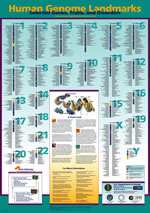Archive Site Provided for Historical Purposes
A Web Companion to the Human Genome Landmarks Poster

The chromosome image below is the online version of chromosome 6 depicted on the Human Genome Landmarks poster.

Click Here for Printable Image
Visit the Image Gallery for high-resolution print-quality version.
NOTE: The Human Genome Landmarks poster is for educational purposes only, and is not intended to provide medical advice. Genes associated with the disorders and other traits listed on this poster were selected from the comprehensive database Online Mendelian Inheritance in Man (OMIM), which designated the status of each of these as confirmed or provisional as of July 2000. The extent of knowledge about any specific gene or disorder varies widely.

Human Genome Landmarks: Selected Genes, Traits, and Disorders
Download PDF
Each of the 24 different human chromosomes featured on this poster can be viewed online.
The Human Genome Project (HGP) was an international 13-year effort, 1990 to 2003. Primary goals were to discover the complete set of human genes and make them accessible for further biological study, and determine the complete sequence of DNA bases in the human genome. See Timeline for more HGP history.
Published from 1989 until 2002, this newsletter facilitated HGP communication, helped prevent duplication of research effort, and informed persons interested in genome research.